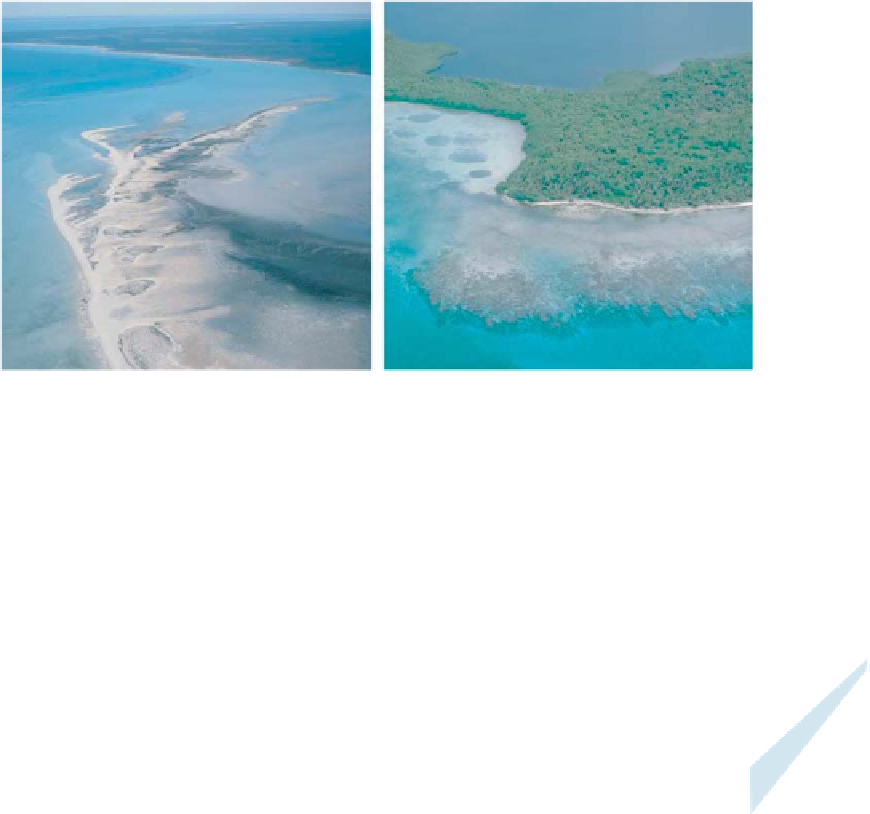Geology Reference
In-Depth Information
(a)
(b)
Fig. 1.
Examples of modern carbonate depositional systems displaying various, juxtaposed environments. (a) Complex spit
of carbonate sands migrating northward along the coast of Shark Bay, Western Australia. Note the closing of lagoon to the
right, with microbial mats (black in picture) developing in the most protected areas. (b) Reef with spurs and grooves on the
eastern (seaward) side of Turneffe Islands, Belize. It is separated from the protected central lagoon (top of picture) by only
a thin vegetated land bridge.
composition and distribution of the depositional
environments. Increased rainfall in the hinterland
carries siliciclastics and nutrients into the carbon-
ate system, whereas aridity increases salinity in
shallow lagoons. Water temperature, water trans-
parency, water geochemistry, nutrient availability
and sediment input are all factors that control the
ecology of carbonate-producing organisms. Sea-
level rise leads to fl ooding of barriers and shallow
islands and causes rapid environmental changes
once the threshold is passed. Light-dependent
ecosystems may lose the photic zone unless they
are able to keep up with sea-level rise. Sea-level
fall, on the other hand, brings light to deeper
environments and can open new habitats for car-
bonate-producing organisms. In other positions
on the platform, sea-level fall leads to subaerial
exposure of previously subtidal habitats and shuts
off carbonate production.
Considering the complexity of today's shal-
low-water carbonate systems (Fig. 2) it must be
expected that the sedimentary record of such
systems is also complex. There is no reason to
believe that Phanerozoic carbonate systems were
less complex than modern ones, although plate-
tectonic confi guration, climatic conditions, ampli-
tude of sea-level changes, seawater geochemistry
and the evolution of the participating organisms
certainly preclude a direct comparison. Further
complexity is added by the fact that only a part
of the history is recorded: information is missing
due to non-deposition and/or erosion, only part of
Fig. 2.
Sketch illustrating that different depositional envir-
onments coexist in shallow carbonate-dominated systems
(tidal fl ats, sabkhas, siliciclastic deltas, beaches, carbonate
sand shoals, lagoons, coral reefs). Arid and humid end-
members exist but also intermediate cases occur, with
seasonal alternations between more humid and more arid
phases. Modifi ed from Strasser
et al
. (1999).
the organisms participating in the ecosystems are
fossilized, and diagenesis may create a preserva-
tional bias.
The carbonate facies models of Wilson (1975),
Jones & Desrochers (1992) and Flügel (2004)
describe facies zones that give a general picture
of the potential distribution of sedimentary envi-
ronments and biota. Read (1985), Burchette &
Wright (1992), and Pomar (2001) have empha-
sized the differences between the geometries of
carbonate ramps and platforms and discussed
their relation to facies distribution and productiv-
ity of carbonate-secreting organisms. Carbonate




























































































































































